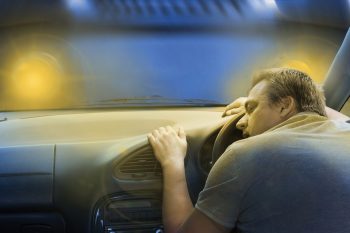Driver safety is a foremost consideration for all fleets but can be particularly tricky where drivers have to work well outside normal office hours. Driving for Better Business (DfBB) advises on how such fleets can make sure their business drivers have had enough sleep and are fit to drive.

There are some eye-opening facts about tiredness out there. For example, the peak times for fatigue-related collisions are between 02.00-06.00 and 14.00-16.00.
Meanwhile, 83% of van drivers say they feel more tired in the autumn and winter and one crash in five is caused by tiredness. Meanwhile, research shows that 20% of people suffer some form of sleep problem that affects their driving ability, by impairing coordination, judgment and memory – and causing longer reaction times. Finally, a driver who is awake for 24 hours is seven times more likely to have an accident.
Although driving when tired is not an offence, it does increase the chance of drivers committing other driving-related offences or causing a serious or fatal collision. There are a number of measures your drivers can tale to make sure they stay alert. These include having adequate sleep before starting a journey; avoiding heavy meals before driving; planning a 15-minute break for every two hours of driving and avoiding taking medication that causes drowsiness. We would also advise stopping in a safe place and take a break at the first sign of tiredness and drinking two cups of coffee or an equivalent caffeinated drink.
Driving when tired or unwell impairs judgement and reaction time causing drivers to react slowly, brake late and is a major factor in a lot of rear end incidents. It also affects coordination, resulting in a variance in speed – slowing down and speeding up. Tired drivers also have what is known as microsleeps, which last from a fraction of a second to two seconds. At 56mph, a van travels 25m/sec, so microsleeping for a couple of seconds means 50m of unconscious travel.
Motorways and dual carriageways are the most common roads for sleep-related road incidents, due to the monotonous road environment and lack of interruptions. Crashes caused by drivers falling asleep involve vehicles running off the road or into the back of another vehicle. They tend to be high-speed impact incidents, where the risk of death or serious injury is high.
There are laws limiting the amount of driving a van driver can do each day. These laws also require minimum rest periods. Drivers breaking these rules can receive large fines and even custodial sentences. The easiest way to understand which rules apply is to assume the more onerous EU Rules will apply unless there is an exemption; these exemptions are legally defined and can be seen at www.gov.uk/drivers-hours/exemptions-from-eu-law. If these apply, you will need a tacho too. If exempt, then the simpler GB domestic rules apply.
The single biggest exemption to the EU rules is that vehicles below 3.5 tonnes GVW are not covered. This means most vans are exempt and will need to use the GB domestic rules unless they are towing. Vans used for towing may still be exempt but for a different reason – you’ll need to check.
To help your drivers, there’s a huge range of free material on fatigue and drivers’ hours at drivingforbetterbusiness.com. There you can also sign up to the Van Driver Toolkit find downloadable toolbox talks and driver information cards.
DfBB has also launched a new Driving for Work Policy Builder. The free tool enables companies to create a legally compliant document to help protect them and their employees – more details are here.

